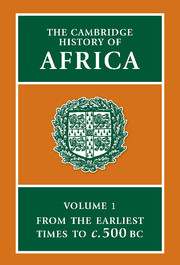Book contents
- Frontmatter
- 1 The palaeo-ecology of the African continent: the physical environment of Africa from earliest geological to Later Stone Age times
- 2 Origins and evolution of African Hominidae
- 3 The earliest archaeological traces
- 4 The cultures of the Middle Palaeolithic/Middle Stone Age
- 5 The Late Palaeolithic and Epi-Palaeolithic of northern Africa
- 6 The Later Stone Age in sub-Saharan Africa
- 7 The rise of civilization in Egypt
- 8 Beginnings of pastoralism and cultivation in north-west Africa and the Sahara: origins of the Berbers
- 9 The origins of indigenous African agriculture
- 10 Old Kingdom, Middle Kingdom and Second Intermediate Period in Egypt
- 11 Early food production in sub-Saharan Africa
- 12 Egypt, 1552–664 BC
- Bibliographical essays
- Bibliography
- Index
- Fig. 3.5 The distribution of sites known or believed to be older than 1.5 million years (i.e. Oldowan). (Modified from J. D. Clark 1967.)
- Fig. 3.6 The distribution of sites known or believed to be between 1.5 and 0.7 million years (i.e. Early Acheulian and Developed Oldowan).">
- Fig. 3.7 The location of Earlier Stone Age and Lower Palaeolithic sites thought to be between 0.7 and 0.1 million years old (i.e. Acheulian plus Developed Oldowan/Hope Fountain).
- Fig. 3.16 The ‘Zinjanthropus’ site at FLK, Bed I, Olduvai Gorge. A plan showing the distribution of an old ground–surface which was uncovered by excavation. A dense patch of discarded artifacts and introduced stones (manuports) coincides with a dense patch of broken–up animal bones. (After M. D. Leakey 1971.)
- Plate Section
- Plate Section
- Plate Section
- Plate Section">
- Plate Section
- Plate Section
- Plate Section
- References
6 - The Later Stone Age in sub-Saharan Africa
Published online by Cambridge University Press: 28 March 2008
- Frontmatter
- 1 The palaeo-ecology of the African continent: the physical environment of Africa from earliest geological to Later Stone Age times
- 2 Origins and evolution of African Hominidae
- 3 The earliest archaeological traces
- 4 The cultures of the Middle Palaeolithic/Middle Stone Age
- 5 The Late Palaeolithic and Epi-Palaeolithic of northern Africa
- 6 The Later Stone Age in sub-Saharan Africa
- 7 The rise of civilization in Egypt
- 8 Beginnings of pastoralism and cultivation in north-west Africa and the Sahara: origins of the Berbers
- 9 The origins of indigenous African agriculture
- 10 Old Kingdom, Middle Kingdom and Second Intermediate Period in Egypt
- 11 Early food production in sub-Saharan Africa
- 12 Egypt, 1552–664 BC
- Bibliographical essays
- Bibliography
- Index
- Fig. 3.5 The distribution of sites known or believed to be older than 1.5 million years (i.e. Oldowan). (Modified from J. D. Clark 1967.)
- Fig. 3.6 The distribution of sites known or believed to be between 1.5 and 0.7 million years (i.e. Early Acheulian and Developed Oldowan).">
- Fig. 3.7 The location of Earlier Stone Age and Lower Palaeolithic sites thought to be between 0.7 and 0.1 million years old (i.e. Acheulian plus Developed Oldowan/Hope Fountain).
- Fig. 3.16 The ‘Zinjanthropus’ site at FLK, Bed I, Olduvai Gorge. A plan showing the distribution of an old ground–surface which was uncovered by excavation. A dense patch of discarded artifacts and introduced stones (manuports) coincides with a dense patch of broken–up animal bones. (After M. D. Leakey 1971.)
- Plate Section
- Plate Section
- Plate Section
- Plate Section">
- Plate Section
- Plate Section
- Plate Section
- References
Summary
Throughout the greater part of sub-Saharan Africa, as in many other parts of the world, the majority of the most recent lithic industries show a marked degree of typological similarity, being dominated by the microlithic components of composite artifacts. It is now known that industries of this type were established throughout most regions of the sub-continent between about the sixteenth and the seventh millennia B.C., although in some places their typological antecedents may be traced back into far earlier times. The broad geographical continuity of the stone industries of this time, together with their correspondence in many basic features with those of the stone-tool-using societies encountered by early European settlers and travellers in southern Africa, lead to the recognition of a loosely defined Later Stone Age. Although of some utility in the general or semi-popular presentation of archaeological material, such broad cultural–stratigraphic terms as ‘Middle Stone Age’, ‘Later Stone Age’, etc. are now seen to be of limited value in the detailed ordering and synthesis of the steadily growing body of primary data.
In much of sub-Saharan Africa, more especially in the eastern and central areas, the study of Stone Age archaeology was largely inspired by pioneer researchers in South Africa. It is to South African work that may also be traced the cultural–stratigraphic nomenclature which has been somewhat acritically applied to industries far removed from the inadequately described sites and industries for which it was originally propounded, as well as many of the models, concepts and misconceptions which have for long been an integral part of African archaeological thought.
Keywords
- Type
- Chapter
- Information
- The Cambridge History of Africa , pp. 410 - 477Publisher: Cambridge University PressPrint publication year: 1982
References
- 5
- Cited by



